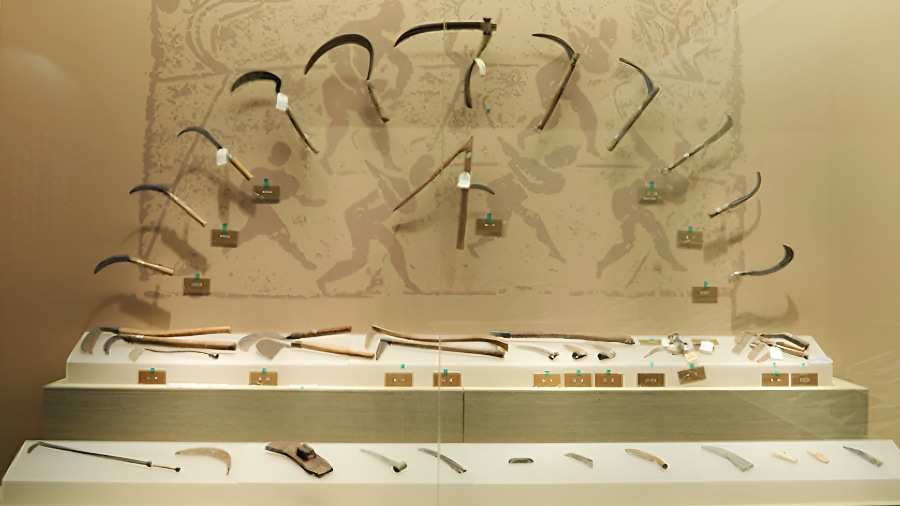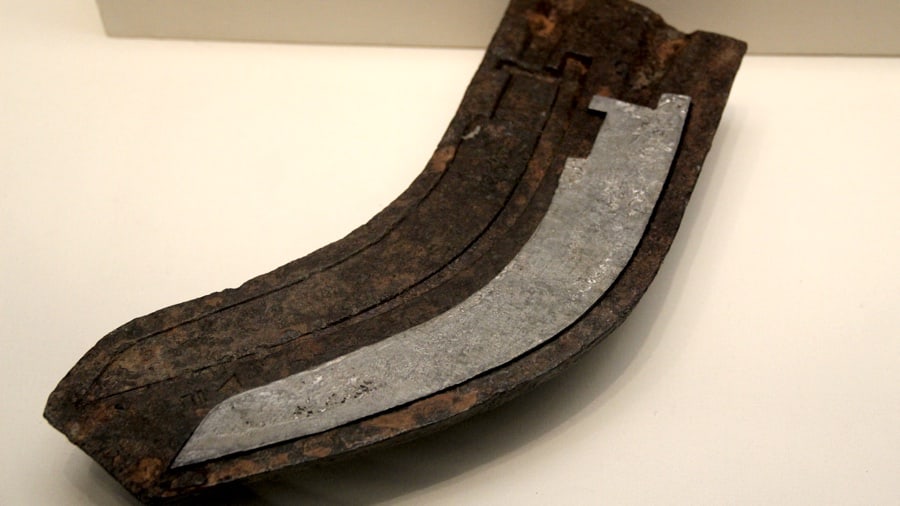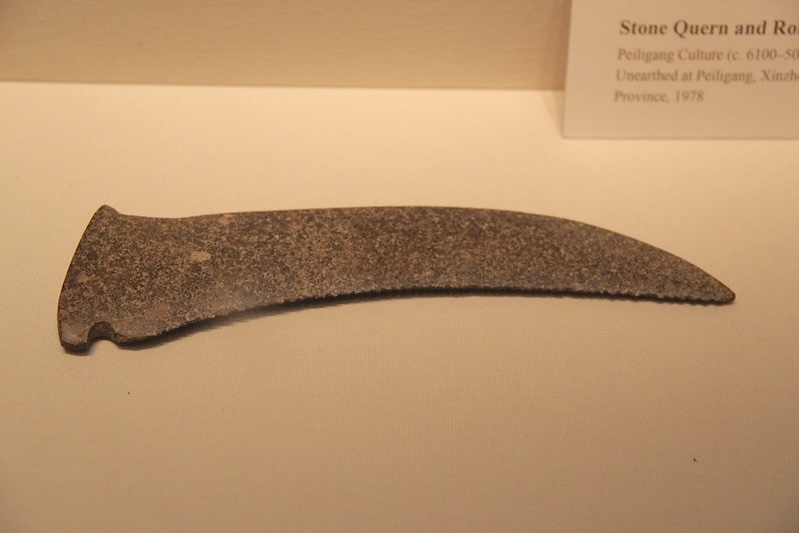
Sickle types displayed at the China Agriculture Museum.
Introduction
The sickle in China, known as lian dao 鐮刀, has a rich history rooted in both agricultural and martial traditions. As early as the Neolithic period, early forms of the sickle were crafted from stone and were essential for harvesting grains like millet and rice. Archaeological findings from sites like Banpo 半坡 (c. 4500–3750 BCE) have revealed primitive sickle shapes made from polished stone, demonstrating early agricultural practices.
The sickle developed alongside China’s agricultural advancements, particularly during the Shang (1600–1046 BCE) and Zhou (1046–256 BCE) dynasties. As ironworking techniques spread in the Spring and Autumn (770–476 BCE) and Warring States periods (475–221 BCE), iron sickles became widespread. Sources such as Shiji 史記 by Sima Qian 司馬遷 mention agricultural tools in the context of societal development, though specific references to the sickle are more implicit.
During the Han dynasty (206 BCE–220 CE), the sickle was increasingly depicted in texts and artwork, reflecting its importance in daily rural life. Han period murals often feature scenes of peasants harvesting with sickles, reinforcing their role as staple tools.

A Warring States period (475 – 221 BCE) iron mould for two sickle blades. Interestingly, the shape for this type, remains exactly the same to this day.
The Sickle 鐮刀 as a Weapon
The sickle’s 鐮刀 evolution into a weapon was a byproduct of agrarian life and periods of unrest, where common tools were repurposed for self-defense. Martial traditions, particularly in southern China, transformed the sickle into a versatile weapon. The bāguà 八卦 and wǔxíng 五行 (Five Elements) practices also emphasised using ordinary tools like sickles to conceal one’s martial intentions. In Chinese martial arts, the sickle 鐮刀 became associated with cha dao 鍤刀, an adapted blade with a hooked design.
The sickle’s role in Chinese martial arts reflects a unique blending of practicality and adaptability, where everyday agricultural tools were transformed into potent weapons out of sheer necessity. The sickle 鐮刀 was incorporated into traditional training systems, where practitioners learned to work with its natural weight and curvature, developing wrist and arm strength necessary to wield the weapon effectively. Techniques often included dynamic strikes, blocks, and entanglements, emphasising both agility and precision.
Legends tell of farmer-soldiers who used sickles 鐮刀 in uprisings, most notably during the Qing 清 dynasty, when peasant revolts like the White Lotus Rebellion 白蓮教起義 (1794–1804) used hidden weapons like sickles to confront better-armed forces.
Stealth Traditions
The following information is from the Zhàn Shì Xīn 戰士心 or ‘Warrior Heart’ Tradition:
The sickle’s adaptability for stealth missions makes it a unique choice for close-quarters combat, especially in confined or indoor settings. Its agricultural origins not only made it inconspicuous during cross country travel but also contributed to its functionality within enemy enclosures. During night missions, the lian dao 鐮刀 enabled stealth practitioners to carry out their objectives with minimal noise and disruption.
The sickle’s curve on the back of the blade, known as the ‘shoulder’ or dao jian 刀肩, became instrumental for sensing the ground in darkness. By gently gliding the shoulder along the floor, the practitioner could silently gauge the terrain, detect obstacles, or even feel vibrations of approaching footsteps. This tactile feedback was crucial for maneuvering undetected, making the sickle a finely tuned tool in stealth and subterfuge.
Additionally, its compactness and ease of concealment allowed it to be used as a backup weapon. When wielded in close quarters, the sickle’s curvature and leverage enabled controlled strikes that required little space to execute effectively, making it ideal for the confined dimensions of an interior. This versatility, combined with the element of surprise ensured that the sickle 鐮刀 was not merely a tool of agriculture but a highly strategic asset in the stealth agent’s arsenal.

Neolithic stone sickle, Peiligang Culture (7000 to 5000 BCE), Jiaxian, Henan, 1976. National Museum: China Through the Ages, exhibit 1. Image credit Gary Todd PhD.
References:
The following is a list of references that trace the history and role of the sickle in China, beginning with Chinese classics and moving to later Western works that discuss this tool’s evolution:
Chinese Classical Sources
- 《周礼》 (Zhou Li) – The Rites of Zhou provides descriptions of agricultural tools and early references to rural implements, including the early forms of the sickle.
- 《齐民要术》 (Qi Min Yao Shu) – Essential Techniques for the People’s Welfare by Jia Sixie 賈思勰 (6th century) is one of the earliest comprehensive agricultural texts. It includes methods for planting, harvesting, and using tools like the sickle.
- 《天工开物》 (Tiangong Kaiwu) – The Exploitation of the Works of Nature by Song Yingxing 宋應星 (1637) describes agricultural technologies, including sickle designs and innovations in tool-making.
- 《本草纲目》 (Bencao Gangmu) – Compendium of Materia Medica by Li Shizhen 李時珍 (1596) includes references to agricultural tools and their uses, showing the sickle’s presence in daily life and folk medicine.
- 《水滸傳》 (Shui Hu Zhuan) – Water Margin, a classic Chinese novel, references agricultural tools in scenes with peasant-heroes, where sickles and similar implements are sometimes used in self-defence or repurposed as weapons.
Scholarly Works and Modern Chinese Sources
- 《中国农具发展史》 (Zhongguo Nongju Fazhan Shi) – History of Chinese Agricultural Tools by Sun Weilin 孫維霖 covers the development of agricultural tools, including the sickle, in Chinese rural society.
- 《中国兵器史》 (Zhongguo Bingqi Shi) – History of Chinese Weapons by Tang Jiqiang 唐繼強 discusses how everyday tools like the sickle were adapted for combat purposes in times of conflict.
Western Works and Scholarly Articles
- Needham, Joseph. Science and Civilisation in China (Multiple volumes, particularly Volumes 4 and 6). Cambridge University Press. – Joseph Needham’s work is invaluable for understanding the development of Chinese agricultural and martial tools. He provides insights into the technological advances that influenced tools like the sickle.
- Schafer, Edward H. The Golden Peaches of Samarkand. University of California Press, 1963. – While not solely focused on agricultural tools, Schafer’s work discusses the economic and cultural exchanges between China and other regions, including the transfer and evolution of farming implements.
- Watson, Burton (Translator). Records of the Grand Historian of China (Shiji) by Sima Qian. Columbia University Press. – This translation of the Shiji provides context for the economic importance of agriculture and tools like the sickle in Han society.
- Temple, Robert K. G. The Genius of China: 3,000 Years of Science, Discovery, and Invention. Simon and Schuster, 1986. – Temple’s work covers various inventions and tools, including a discussion on agricultural practices and the technological advances that shaped tools like the sickle.
